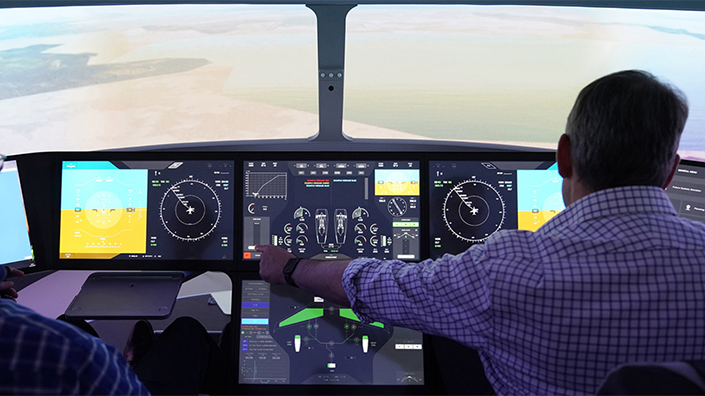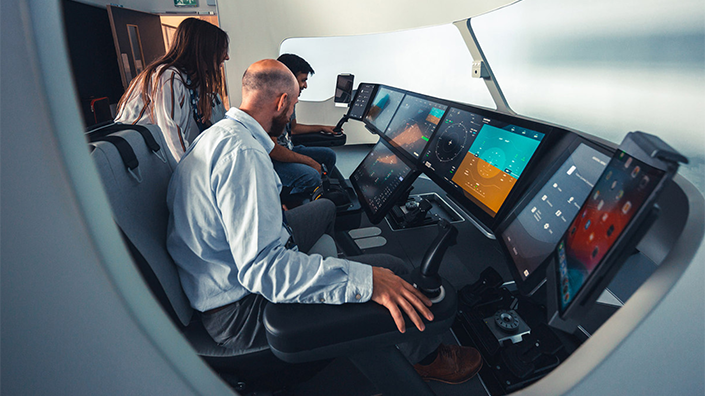New technologies have the potential to radically change the cockpit of the future. Engines are getting smarter – they are collecting more data and capable of making more autonomous decisions. Because these smarter engines have more to say, it may be time to rethink the way that we present their information to the pilot. A little further into the future and electric planes are set to become a real possibility, not only changing the conversation between the engines and pilot but also the task of flying the aircraft itself.
Rolls-Royce’s Future Systems Simulator (FSS) is a purpose built test bed designed specifically to explore these challenges. It is highly configurable, allowing the number of pilots to be varied and the locations of major controls to be changed. It is built around a test-learn-update-test again cycle.
Development of the FSS was an incredibly ambitious project, which was only successful as a result of the seamless collaboration between leading academics from Cranfield University, experts and pilots from Rolls-Royce, and a leading multi-disciplinary design consultancy DCA Design International which designed and built the FSS.
Why build a testbed?
There is a remarkable story that ergonomists (or human factors specialists) love to tell. It’s a story about an ergonomist, called Alphonse Chapanis, who was tasked by the USAF with understanding why B-17 bomber pilots were inadvertently retracting the landing gear upon approach. Rather than leaping to the conclusion that more training was needed, Chapanis took the time to study the layout of the cockpit and compared it to other similar aircraft. He revealed that, unlike other aircraft, the B-17 controls for the landing gear and the flaps were almost identical and directly next to each other – making them easy to mistake. To remedy the issue, Chapanis designed ‘add-ons’ for the controls (a rubber wheel for the landing gear and a small wooden wedge for the flaps). This simple fix was applied to the fleet and eliminated future instances of pilots inadvertently retracting the landing gear.
The reason ergonomists love to tell the story is that it is powerful on several levels.
- It highlights that even highly trained individuals (who have been through a tough selection process) can make mistakes if the products that they are required to work with are not optimised.
- It shows how a structured and systematic approach can identify the underlying cause of use errors.
- It highlights how, often simple, design changes can have a profound impact on system performance (e.g. safety).
The story of the B-17 bombers is now a very old one, but it’s one that remains relevant today. A number of more recent events have shown that a lack of appropriate information being available to the flight crew can still result in the incorrect decisions being made. These are poignant reminders that further opportunities for optimisation exist.

Developing a visionary testbed
Flight simulators are most commonly thought of as training aids. They provide safe environments for pilots to experience rare events (such as engine failure from bird strikes) and develop their skills and experience in responding to these events. As ‘safe environments’, simulators also have another core advantage that they allow new cockpit interfaces to be tested to ensure that they are optimised for use and system performance.
Rolls-Royce is pioneering new technologies to monitor and control engines as well as revolutionary new propulsion technologies. Acutely aware that even the slightest changes in the design of these spaces can have a profound impact on system performance, Rolls-Royce has embarked on an exciting programme of work to develop a Future Systems Simulator (FSS) to act as a testbed to explore how these new technologies will change the task of flying.
The vision for the FSS was clear – to develop a highly reconfigurable open platform interface that allows both exploration of potential near-term changes to the flight deck, as well as providing a test-bed for revolutionary new technologies to be tested by currently serving airline pilots.
The FSS is located in a dedicated space within Cranfield University’s Aerospace Integration Research Centre. The simulator has been developed to be independent of any given airframe or manufacturer, yet reassuringly familiar to those used to traditional aircraft control types. As such, it’s possible to represent anything from relatively small single seat aircraft to the largest jumbo jets.

When pilots strap into their seats, they are provided with a panoramic view of the external world presented on a large wrap-around display. Their internal information can be presented across four large touch screens and an additional two smaller side screens.
Pilots can interact directly with the touch-screens as well as through relatively conventional repositionable side sticks and thrust levers.
Behind the scenes, the simulator is powered by realistic flight models generated by aviation experts from Cranfield University. These models are informed by a detailed understanding of flight mechanics, weather patterns, and engine characteristics, all of which are fully configurable. This allows for new propulsion technologies to be modelled and flown. These models are the heart of the FSS, controlling the external world as well as providing the inputs to the internal displays and even tactile feedback to the physical controls.
Collaborative approach
The physical layout of the cockpit displays and controls was directly influenced by the ergonomic needs of the pilot. While this started on paper, with anthropometric mannequins, a full sized MDF rig was built by DCA early on in the project to test assumptions with pilots and to gain additional feedback. This philosophy of stakeholder engagement continued throughout the project. Multiple interface layout iterations were assessed with test pilots in the physical mock-up. The final position, reach and size of elements was particularly influenced by this feedback.
Both the physical and the digital elements of the system have been carefully crafted to provide a glimpse of the future grounded in logical familiarity, while retaining the sense of total flexibility for further development.
Alternative haptics
While a touch-dominant interface provides the most freedom for future applications, the interface aims to replicate existing cockpit design principles as well as conveying a high-level of tactile feedback. All critical control interactions were designed to reduce the chance of false inputs.
From the beginning, the physical and digital configurability was designed to support the broad range of systems in development, from electrifying existing platforms to investigating novel, autonomous, electric vertical take-off and landing platforms.
Exploration without limits
The FSS has been designed by DCA to be reconfigurable at both a physical and a digital level. By adjusting the seating configuration (single, twin, or three side-by-side), it can accommodate the traditional set of pilots, or be used to evaluate future control paradigms including single pilots with a remote co-pilot.
Different physical controls can be introduced or even completely removed. The number of screens can also be changed along with their locations – all within a short space of time – allowing it to closely represent a variety of civil aircraft control philosophies.
The digital elements of the FSS are, of course, also fully reconfigurable. The full colour, high-resolution (4K), touch screen displays allow multiple pilots to interact with the system at the same time.
A vision to be proud of
Today, FSS is a fully flying simulator and is being flown by pilots as part of cutting-edge research into future aircraft interface concepts.
The FSS is, quite simply, a researcher's dream as it allows an almost endless number of experiments to be accommodated. Exploring key questions facing aviation including single pilot operations, distributed crew operation with pilots on the ground, the suitability of new technologies, and a platform for exploring new innovative ways for pilots to receive information and interact with it.
From the start, the design and construction of the FSS was an ambitious project, completed within seven months. It showcases what can be achieved when a diverse team, including experts in flight dynamics, industrial design, interface design, human factors, mechanical engineering, electronics, software, and prototyping, come together with a shared vision.
The success of this collaborative effort was recently formally acknowledged when it won a coveted 2021 iF Design Award in the Product User Experience (UX) category.
Want the best engineering stories delivered straight to your inbox? The Professional Engineering newsletter gives you vital updates on the most cutting-edge engineering and exciting new job opportunities. To sign up, click here.
Content published by Professional Engineering does not necessarily represent the views of the Institution of Mechanical Engineers.